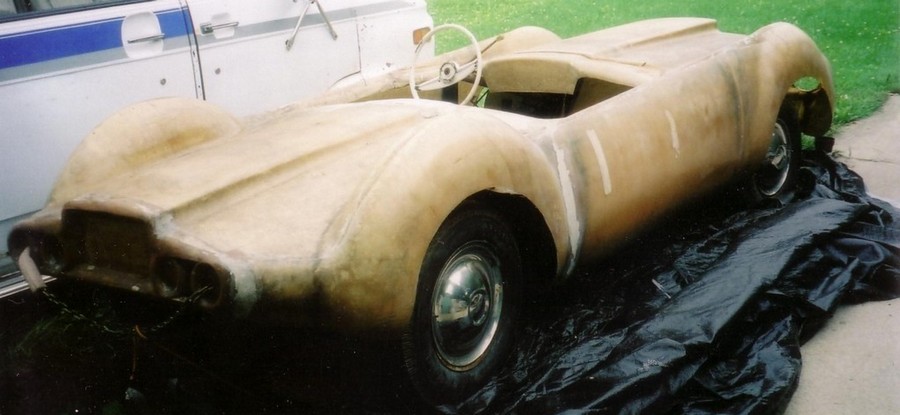
Hi Gang…
In the past year, I’ve been honored to meet and get to know many new people interested in these cars. While I consider all of them friends, some of them come armed with additional energy and enthusiam – even more than I have. No one fits this bill better than my good (new) friend Darren Swansen.
This past summer, Rick D’Louhy and I had a chance to visit with Darren in his hometown of Bloomington Illinois, and chat a bit about his cars and car interest. I even included a picture of our first meeting as well (below). What has Darren really stoked has been his recent acquisition of a Mysterion we call the “Kaiser Sports Special”. I asked Darren if we could post his quest for knowledge concerning this car on our website. A few days later, I received the longest e-mail I have ever gotten. Even longer than one of my e-mails. You can’t fault Darren for an extra appetite for research and knowledge. Hats off to him there.
Darren’s e-mail to me appears below. And….to make sure Darren reads this post again…I have put in 1 or 2 links to a car that might help with his research. Let’s see if he catches these 2 links at the bottom of this story….I’ll check the forums after this story is posted to see if he has read it. My bet is that he already has found this info on a similar car but….let’s see what he says.
Don’t forget we have a new section on “Mysterions” or mystery cars on our website and I am trying to add several mystery cars each week for your review. Hope you enjoy this new feature. It can be found under the link “More Information”. Here’s a link directly to the page:
https://www.undiscoveredclassics.com/?page_id=928
Thanks again to Darren for the story below, and we all wish you good luck in tracking this “Mysterion’s” history down.
Geoff
———————————————————–
Hello all….
This fiberglass mystery car is based on a 1951 Kaiser Henry J chassis which started life at the Willow Run plant in Ypsilanti, MI. Despite having six owners, 5 of them between 1999/2000 and 2008, since it left the factory in 1954, the car remains virtually untouched and unfinished after nearly 55 years.
Over the years the car has remained relatively hidden away and unseen by the general public and literally out of the daylight for much of the time, but has developed a bit of a legend and lore in the Detroit area. Some people believe this to be a factory concept/prototype car and others are certain that it was built in someone’s garage.
Below are some details about the car, body, ownership and currently known history and research performed on the car to date.
History of Chassis:
Based on the serial number, 10079, and information provided by several Kaiser Historians, an approximation was made for when the chassis rolled off the assembly line. It is believed that this serial numbered chassis rolled out sometime during the month of October in 1950. It remained at the factory until July 23, 1954 when Edwin F. Hasley, a tool and die maker from Detroit, purchased it for $200.00. By that point in time, the Kaiser Company had completed their merger with Willys and was moving their offices and factories to Toledo, OH and the Willow Run plant had been sold to GM/Chevrolet.
Getting back to the engine and chassis, the car has an 80 bhp, 161 cubic inch Kaiser Supersonic 6 (Willys L-head) attached to a 3 speed manual transmission with Borg Warner electronic overdrive. This engine and transmission setup was an option on Henry J cars and the title and paperwork indicate Deluxe model. As an added note, there is some confusion as to the engines used by the various Kaisers. Early full size Kaisers used a Continental based six, while all of the Henry Js used a Willys based flat head 4 or 6 and the Kaiser Darrin used a Willys based F-head six which had overhead valves and provided an additional 10 bhp over the Henry J 6 cylinder engine.
The engine appears to be stock except for a Holly carburetor, which was not an option on the production cars. Close inspection of the base of the carburetor shows the paint to be a match to the engine color. Research by another owner and me suggests that the designer/builder was intending to use a Paxton 57 supercharger on the car. Unfortunately, there is no supercharger with the car or parts, but photos of several Kaiser Engines with superchargers were in with the paperwork. A belt driven Paxton supercharger would boost the horsepower to 110-120 bhp.
Unlike the Kaiser Darrin chassis which was based on the Henry J the chassis rails and has a drop just ahead of the rear suspension mounts, this cars chassis is a bone stock Henry J chassis.
The odometer reads 35.4 miles and are believed to be original (and most likely towed) miles. The car still retains its original Goodyear Super Cushion 5.90×15 tires which still have the rubber nubs on the tread edges and excess rubber from the mold halves down the middle. The hubcaps that are on the wheels are All State units. The All State was a modified Henry J branded for Sears. Alex Tremulous and Phil Egan who designed the exterior and interior (respectively) of the Tucker were responsible for the trim and design changes to the Henry J for the All State/Sears project. There is no radiator or gas tank, but fuel and brake lines exist along with an exhaust system to the back of the muffler. The exhaust system shows some rust, but no other discoloration. A check of the engine oil shows no carbon in it or on the stick and is so clean and clear that my first thought was that it was water instead of oil.
Body:
The body is a fiberglass shell that appears to have been hand laid in a mold. Based on color and cloth texture, and input from several people who have worked with fiberglass, the general belief is this is old (early) fiberglass material. There is no gel coat, nor paint or primer on the body. The fiberglass is fairly thin and the shell can easily be lifted to head/shoulder height by two people. The workmanship of the fiberglass and resin indicate that the builder/designer had experience with fiberglass and mold making techniques as the sides and fender arcs are symmetrical from side to side and front to back. You can also see some “texture” of the mold in the resin, supporting that a mold was built and used to make the shell. Where pieces of fiberglass cloth meet, the seams are cleanly cut and transition smoothly again indicating experience and care were taken during the build and laying process. The keen eyes of my 12 year old daughter discovered a small moth caught in the resin along the top edge of the driver’s door. While this doesn’t provide much history, it does help identify approx. time of year that the body would have been built. This type of small, thin, moth is seen frequently in this portion of the country (Wisconsin, Illinois, Indiana, and Michigan) between late August and early November . Getting back to the body, the body shell was never completed as it has no interior/floor, not trunk pan or firewall and no supporting structure. The doors, hood and trunk haven’t been marked or cut out, and there are no body mounts, yet there is a recessed area for a windshield frame, and several smaller fiberglass pieces for “A” pillars. Another interesting item in the body is an embedded penny. Located in the top of the right rear fender arch, it is parallel to the ground, indicating placement and not an accidental “drop” into the resin and cloth while being molded. With a layer of cloth covering the penny, you can only see the outline of the penny and cannot read any details of the penny itself. Various theories about what the penny is for, what it means, etc. have been floating around and are part of the lore/legend of this car.
Design wise, the hood and body are fairly low, with high arching fenders over the wheels. A “scoop” starts near the front of the body, runs back to the cockpit and picks up again behind the cockpit and runs to the tail of the car where it blends down into the license plate and taillight area. The hood and fender shapes remind me somewhat of Ford Muroc (3/8 scale model) by Gil Spears Jr. and a model that can be seen in the background of a photo I have of Alex Tremulous. All these cars have very similar side profiles and hood areas. The front and rear of the three are dissimilar although this car and the Muroc both have headlights mounted to the outer edges of the grill which was not a common design trait in the early to mid 1950s. Several people have commented how the rear, with four taillight mounts, license plate area and scoop look somewhat “Corvair-ish”, yet the Corvair didn’t arrive on the scene for several years. A drawing that came with the car and other paperwork shows a short and long wheelbase version and indicates the hood scoop was to be opened up and the grill work was to be egg-crate/waffle in design. When looked at the drawing or the front of car you will notice a slight “dip” or widows peek in the center of the grill opening. This car is the “short’ wheelbase version.
Owners and Ownership History
Edwin Hasely was the first owner of this car and purchased it (or at least the engine/chassis setup) from the Willow Run plant on July 23, 1954. Edwin retained ownership of the car and a lot of the sales documentation until he passed away in August of 1999. His family shared the following story with me.
“I was six years old when my uncle bought the car and brought it to the shop that he and my father owned. It always sat in the back of the shop, and moved to their new location in the early 1960s. My uncle had many projects but never completed them all and was a “saver”, so when I sold the car I put anything that might go with it in it.” “Over the years I was told two different stories about the car. The first story is that the car came from the Kaiser Design lab and was built by someone who knew my uncle. The second story is that the car came from the Kaiser Design lab where it was built for my uncle.”
His nephew also shared with me that Edwin flew B-24 bombers that were built in the plant to Florida during WWII and knew many people who worked there and later became Kaiser Factory employees.
While settling the estate (approx. 1999/2000), the car was sold to its second owner, who owned a hot rod/custom car shop in Detroit, for $1500.
The only other details about the second owner that I have are that he closed the Detroit shop and moved to the Northwest (Wyoming, Washington, Idaho). He is the only owner whom I have been unable to locate and speak with.
The third owner was from the Armada, MI area. He owned the car for a couple of years (approx. 2005/2007). He enjoys unique and unusual cars and currently owns an Essex hot rod. He intended to research this car and build it at some point, but traded it to a man near Memphis, MI for a 1970 Mustang. While he owned it, he did a little research on the cars history and found several former Kaiser plant employees. One of the envelopes of paperwork has the names F.E. Reynolds and R.J. Jeeperson on it. He believes he spoke with one of them, but couldn’t recall which. Both of their names appear on the original sales documentation/paperwork. He also says that several former employees said they recall seeing the body in the plant while several others say they never saw it and don’t think it was built there. One said the employee who built it knew the first owner.
The 4th owner, upon buying it said that he would never sell it and was going to build it as a hot rod, putting a big block in it, etc. etc. He owned the car for approx 1 year, but never did much more than put some fuel in the carburetor and run the engine briefly. He attempted to sell it several times, between August and September 2008 on eBay, listing it as THE Prototype Kaiser Darrin and the 1946 Darrin (another fiberglass car, built by Howard Dutch Darrin) asking $400,000 and $30,000. It is neither, as both are fairly well documented cars with photos of each and both are known to have been complete, running vehicles. Research also supports that he approached RM Auctions about selling it. They declined due to current state of the vehicle and the lack of supporting documentation (that it is a factory prototype). He sold it sometime around October 2008 for an undisclosed amount.
The 5th owner(s) had the car for about a month, believing that they could research and prove that the car is a prototype, and realized the amount of research that it was going to take to determine what the car is/isn’t, was more in-depth than they planned. They decided to sell it on eBay in December of 2008.
I am the 6th owner and purchased it in mid December of 2008 off of eBay for $3,000. The car now resides in Illinois, and came with a significant amount of original sales paperwork from the factory, the original keys (with the factory identification tag on them), and the original title that was issued in 1951. One of the first people I spoke with while researching the car was a Kaiser employee who worked as a company photographer from 1948-1978. He has examined the paperwork, drawings and photographs and provided a very nice and detailed letter back to me. In the letter he expressed his opinion. He does not recall seeing the car at the factory, but goes on to state that it is possible that this may have been an enthusiastic employees effort to present an idea or a non-company sanctioned/side project.
People I’ve spoken and been able to determine that they were not involved with the car/body.
- – ??? Miller (worked for Kaiser, Chrysler and Ford)
- – Alex Tremulous (Tucker, Kaiser, Subaru, space shuttle, etc.)
- – Bill Tritt (Glasspar G2, Volvo, and consulted for GM on the corvette and Dutch Darrin on what became the Kaiser Darrin)
- – Brooks Stevens (Kaiser, Jeep, AMC, and Studebaker, and the Oscar Myer Weiner mobile).
- – Gino & Cesare Testaguzza (Designers of the La Saetta car. One of the brothers also did some design work for Ford and several other car manufactures)
- – George Barris – well know car customizer. Several people have suggested this lead.
- – Carol Shelby – another suggestion.
- – Andy Schroyer
- – William F. Pierson – Designed the Alken Roadster
Ongoing Research-
- – Phil Egan – Also tied to Replac Debonair/Venturer
- Alfred Ray Russell – Tied to Detroiter (1953)
People/families that I have been unsuccessful in locating are:
Howard Dutch Darrin’s family.
- F.E. Reynolds and a R.J. Jeeperson. These two men are listed on the original sales documentation for the car. If the car truly was sold as a Henry J chassis and fiberglass body/prototype, etc. it would have been different enough that they may remember or have shared with their family.
Future research
- Herb Weissinger – Kaiser and Ford designer
- Buzz Grisinger – Kaiser and Ford designer
- John Chika
- James Anger
- Frank Morris
- Herb Todd
- Damon Woods
- Duncan McRae
- Chalres Phaneuf
- Gordon Tercey
- Cliff Voss
- Al Sartor
My desire and goal is to try and identify the designer(s) of the car, determine the intended vision of it so that it may be completed as such, and provide recognition for those who started it. If that cannot be accomplished, I will build the car as an era correct sports/racer with some modern updates for safety and maintenance.
| Technical Specifications | |
| Body | (Currently unknown) |
| Paint | Glass and Resin |
| Upholstery | none |
| Frame | ’51 Kaiser Henry J (stock) |
| Suspension | Kaiser Henry J (stock) |
| Engine (make/year) | ’51 Kaiser Supersonic 6 (Willys F-head) |
| Displacement | 161 CID |
| Horsepower (estimated) | 80 |
| Transmission (type/year) | 51 Kaiser – 3 speed manual with Borg Warner electronic overdrive. |
| Rear Axle / driveshaft (open/closed driveshaft) |
Kaiser live axle, semi-elliptic leaf springs, 4.10 gear. |
| Wheelbase | 100 inch |
| Track/Tread (front/rear) (distance between center line of tires) |
57 1/2″ |
| Tire Size | 5.90×15 |
| Curb Weight | approx 1500 lbs |
| Weight Distribution | N/A |
| Top Speed (0-60) | unknown |
| Special Features | Penny embedded in body |
———————————————————————————————————
Here are three links that may help Darren with his search…
https://www.undiscoveredclassics.com/?page_id=1101
http://www.fiberglasssportscars.com/Motorama/1955/Program/Program_1955.htm
http://www.fiberglasssportscars.com/Motorama/1955/Program/Motorama_1955_Page_06.jpg
Geoff
——————————————————————–
Click on the Images Below to View Larger Pictures
——————————————————————-
- Darren and Geoff meeting at a Health Food restaurant for the first time
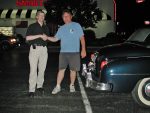

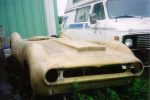
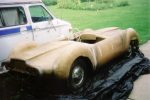
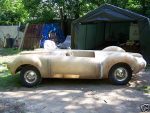
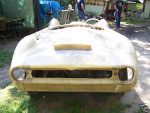
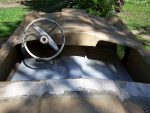
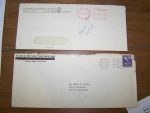
You can find John Chika’s son in Clarkston , MI Chika was my Great Uncle. I can’t wait till you do your research about John Chika the five cowboys !